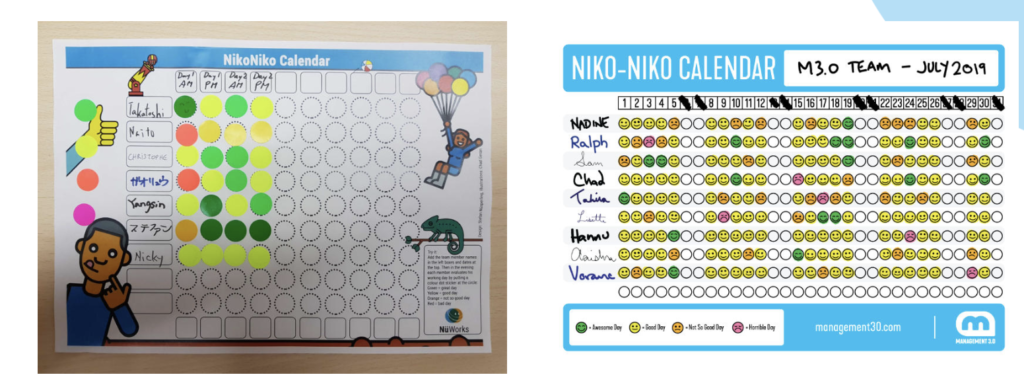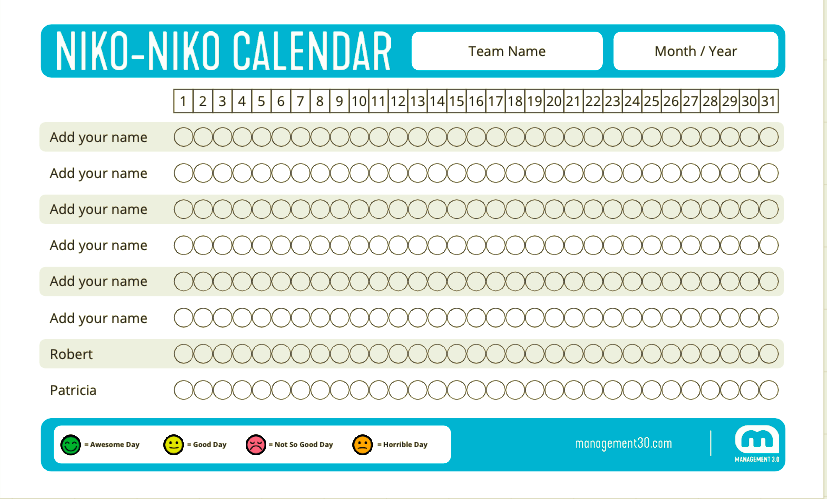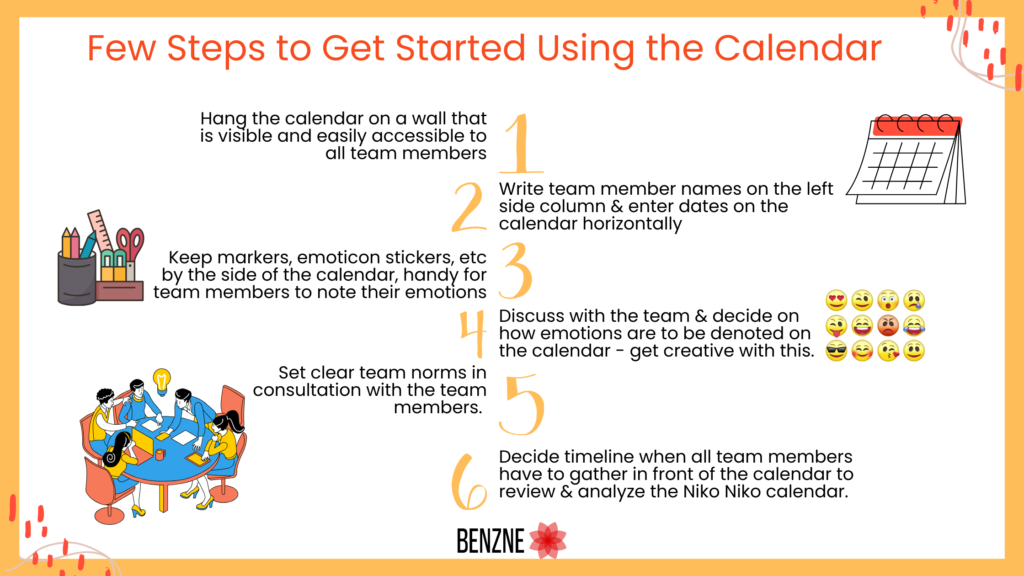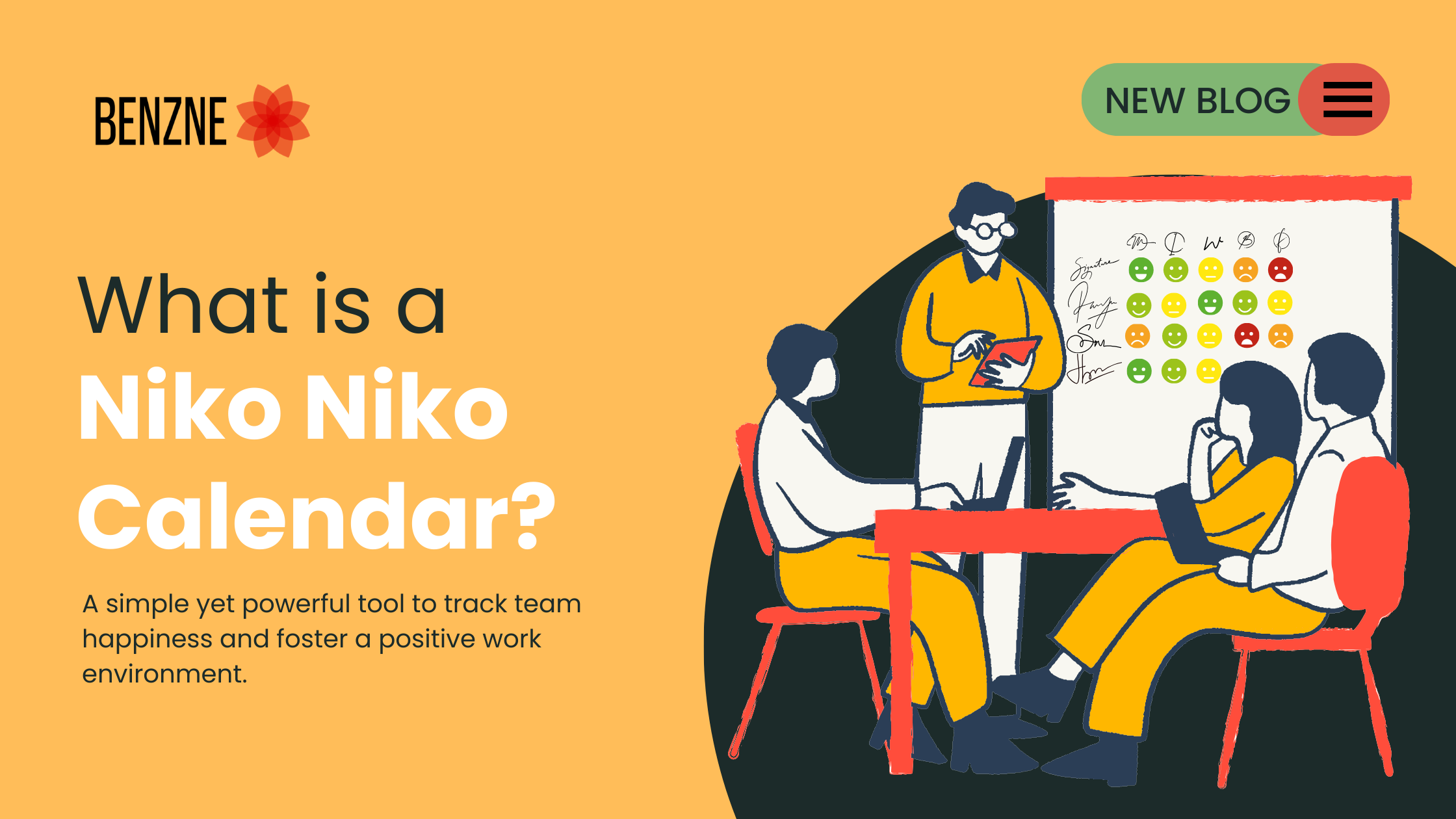Introduction About Niko Niko Calendar
Have you ever conducted an elaborate team engagement survey and found some numbers pointing to the team’s health but lacked a good insight into the real issues?
Have you been left only with data points but no better understanding of the actual emotions of the team?
Do you struggle to use the data gathered to know the mood of your team?
Have you bored the life out of your team conducting exhaustive exercises to get their pulse?
If the answer of any of the above is a yes, then you should look no further than the Niko-Niko calendar to help you out, and that too in an easy, non-exhaustive, fun-filled way.
We will attempt to answer the below questions and more in this blog based on our experience as an agile strategy consulting company:
- Why is team health important?
- What is a Niko Niko Calendar?
- Examples of Niko Niko Calendar
- How to use a Niko Niko Calendar?
- Can we use a Niko Niko Calendar Template?
Why is the team’s health so important?
A team’s health is a very crucial factor to consider when striving to build high performing teams. Healthy teams often deliver better products and services – and to be clear, we are talking about mental health here. A healthy team helps the management uncover issues that may cause needless bottlenecks and inefficiency easily. It is crucial to understand the undercurrents in the team and to measure its health, especially in organizations where psychological safety is less emphasized.
Healthy teams are an important asset in the modern creative economy, where the siloed, gated work culture and processes have been replaced by the collaboration, ideation and iteration led ways of working. We have delivered context-driven psychological safety workshops across organizations in very different domains and have been pleasantly surprised by the power and impact of awareness and empathy around the topic and how well-received the topic is across various levels. This blog focuses on one of the ways of understanding the mood of the team members periodically.
What is a Niko-Niko Calendar?
So, what is a Niko Niko calendar exactly?
Niko Niko calendar, invented by the Japanese (Niki Niko loosely translated to smile), are tools used to track the happiness index of a team. Essentially this tool captures the mood of the team members – as in if they are glad, mad, sad, frustrated, happy, or gloomy. Thus capturing the team members’ emotions which helps us to track, visualize, and evaluate their feelings over time.
While there are many other ways of measuring happiness quotient, the uniqueness of the Niko Niko calendar is that it introduces a fun element to the process. This calendar is usually pasted on a wall, where it is visible and accessible to the entire team. Every member of the team is expected to post his/her emotion of the day on the wall, by way of a smiley or a representative color. This kind of information radiator brings transparency and openness across the team. Management can then use such an index to understand and analyze indicators, patterns, and trends of emotions displayed. Which enables them to plan and act proactively towards improving the emotional well-being of the team.
Best Examples or Templates For Agile Niko Niko Calendar
Niko Niko calendar can be used in both online and offline modes. One can print the template from https://management30.com/practice/niko-niko-calendar/. This printed version should be pasted on the wall. When the team is physically present in the office the above printed version could be used.

When the team is distributed or in a hybrid working model Niko Niko calendar online template from https://miro.com/app/board/uXjVKEaMOoY=/ is a great way to start. Apart from the ones mentioned above, there are many Niko Niko calendars online for free.

How To Use A Niko Niko Calendar?
Various Niko Niko calendar templates are available online, any of which can be downloaded, printed on a colorful chart sheet, and pasted on a wall accessible to the team. The calendar should have the names of the individuals and the time frame printed.
Note: We have included a few useful template links at the end of this blog for easy reference, feel free to use them and let us know your experience.

Here are a few simple steps to get started using the calendar:
- Hang the calendar on a wall that is visible and easily accessible to all team members
- Write team member names on the left side column and enter dates on the calendar horizontally
- Keep markers, emoticon stickers, etc by the side of the calendar, handy for team members to note their emotions
- Discuss with the team and decide on how emotions are to be denoted on the calendar – get creative with this. The two common ways of denoting emotions are:
- Using different colors to represent varying emotions.
Example – Red for anger, Blue for sad, Green for happy, etc.
- Using emoticon stickers to denote emotions for the day.
Example – Happy smiley, frowning smiley, angry smiley, etc.
- Set clear team norms in consultation with the team members.
Example – Each team member has to put his/her emotion on the calendar at the end of the workday, no matter what.
- Decide on regular intervals the timeline when all team members have to gather in front of the calendar to review and analyze the Niko Niko calendar.
A Few Basic Tips And Examples To Interpret And Analyze Calendar Data
- All happy emotions – could be a call for celebrations or the team could be getting complacent? Dig Deeper, for example – Why is the team happy post a failed sprint?
- Mixed emotions – could mean clashes or turmoil within the team or there may be some permanently disgruntled team members? Probe more – Are there siloes forming within the team?
- All unhappy/sad emotions – something terrible going on that may be messing with the entire team or a specific experience that could be upsetting the team. Understand Why? Seek help from the management.
Please note that emotions can be related to the events that happened in the past cycle and not the current one – analysis and actions need to be adequately planned and analyzed in the right context.
Some Caveats to consider –
- A few people might not appreciate the underlying format of feedback collection – and may feel childish penning down their emotions for open display. So it is best to check with the team on how they feel about this tool and process before putting things in motion. Everyone needs to be comfortable and on-board with the tool.
- Metrics from this tool are not quite quantifiable, thus making an analytical approach a little difficult to achieve. It could be an idea to use other quantitative tools in combination with the Niko Niko calendar, for a more well-rounded approach. However, experience, empathy, and perception will make the tool very effective in the right hands.
How Niko Niko Calendars Can Help You Drive High-Performance Teams?
Some of the ways in which Niko Niko Calendar can really help drive high-performing teams are mentioned below:
- Better understand the team’s happiness quotient or emotions: Understanding the emotional state of a team is key to its success, especially in the case of geographically distributed or remote teams. In our opinion, the easiest, fastest, and most visual way to check on a team’s emotions is by the use of the Niko Niko calendar.
- Regularly acknowledge the team’s emotions: Noticing and recognizing the emotions of team members periodically is fundamental to building and managing a high-performance team. Publicly acknowledging the happy or sad emotions automatically boosts the morale of the team as they feel that they are being heard. Special callouts and simple celebrations when team members showcase happy emotions also go a long way in improving teamwork.
- Trigger timely actions to make the team feel valued and supported: Employees often feel recognized and valued when management responds in time to their emotions and actions. Lending an ear to people in the team, calling out positives, making simple celebrations, addressing challenges, etc. are a few examples. The transparency and process of Niko Niko calendars go a long way in helping management time their responses to the “T”.
- Provide the team with an opportunity for reflection: Niko Niko Calendar helps management and team members to step back and assess the pulse of the team very quickly and effectively. The ease and speed of feedback help management to stay in sync with the team’s emotional health.
- Identify problems faster: Niko Niko calendars complement other team metrics (agile metrics included) quite nicely, by lending a people perspective to them. Additionally, in our experience this makes many of these metrics more effective, often helping to understand problems faster.
Conclusion
The Niki Niko calendar is a simple, fun, and effective tool to help understand the health of the team members and to raise awareness about team health. It is easy to develop and deploy, Niko Niko calendar helps bring greater openness, awareness, and collaboration across teams. All in all, the Niko Niko calendar is a great option to measure and drive the happiness quotient of a team. We have used them extensively in our client as an agile transformation and consulting company.
You can download a calendar template from the links below and get cracking with your team. And be sure to share your experience or questions in the comments below.
Some useful links for the Niko Niko Calendar templates:
Frequently Asked Questions
1) What are the 4 types of meetings in Agile?
The four main events or types of meetings are as follows
- Sprint planning: The work to be performed in the Sprint is planned at the Sprint Planning.
- Daily stand-up meeting: Daily meeting between all Development team members to review the progress against the sprint goal and use the learnings to inspect and adapt the next day.
- Sprint Review: Demonstrate and review the product increment from the sprint. The review is at the end of the sprint by the Development team to the Product Owner and other relevant stakeholders.
- Retrospective: Retrospective is the formal meeting conducted at the end of the sprint to continuously focus on inspecting and adapting. It is used to identify improvements for the upcoming sprint(s).
- There is an additional 5th event – Backlog Refinement: Understand the user stories planned for the next sprint by the Product owner. Brainstorm with the development team members, estimate and slice stories (if needed)
2) Who is the father of scrum?
Jeff Sutherland is the father of Scrum. Ken Schwaber and Jeff Sutherland together published “The SCRUM Development Process” at a conference in Austin in 1995.
3) What is a sprint calendar?
A sprint calendar is a schedule of all the Scrum events planned for the Development team. Typically includes timeboxed Scrum events. All 5 events/meetings ( Daily Standup meeting, Sprint Planning, Sprint Review, Sprint Retrospective, Backlog Refinement), timings, and days allocated for these events are captured in the calendar.
4) What are agile sprints?
Agile Sprint or iteration is a timebox of 1 to 4 weeks. It’s an iteration in which the team produces a shippable product increment. Once the sprint duration is fixed there is no change in the Sprint duration or Sprint Goal
5) Who manages the backlog?
A product backlog is a list of work items ( user stories, tasks, bugs) to be implemented in the product over several sprints. Product Backlog is one of the outputs from a user story mapping session. The product backlog is owned and managed by the Product Manager/Product owner. The Product Owner sources information from the product team or other relevant stakeholders to populate the product backlog. The Product Owner is the single source of truth for the backlog.
Achieve enterprise agility with SAFe® Consulting. Scale teams effectively, deliver faster, and transform your business into a Lean-Agile powerhouse.

